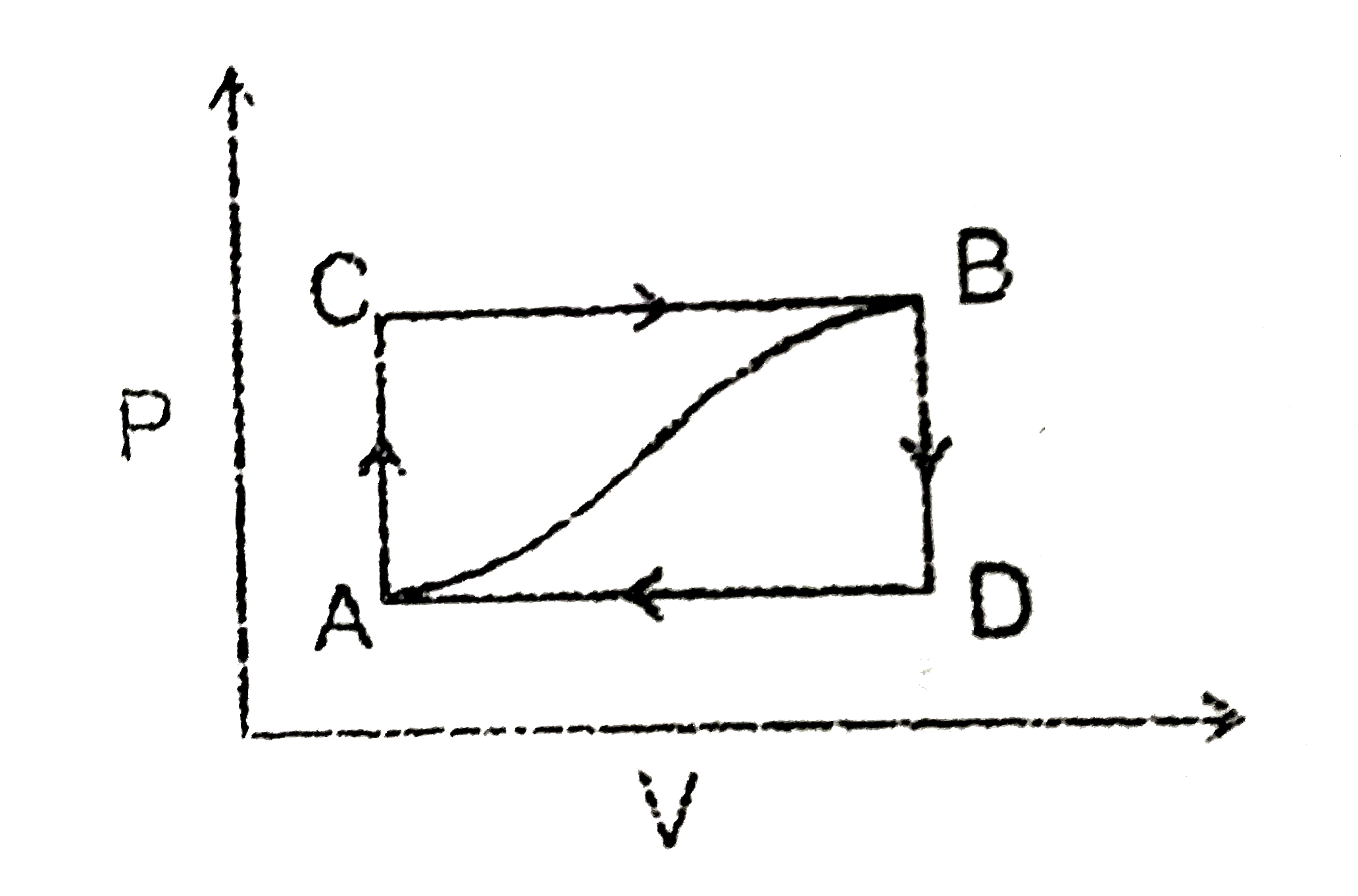When a gas expands along AB, it does 500J of work and absorbs 250 J of heat. When the gas expands along AC, it does 700J of work and absorbs 300J of heat.
(a) How much heat does the gas exchange along Bc?
(b) When the gas makes the transition from C to A along CDA, 800J of work are done on it from C to D. How much heat does it exchange along CDA?

The correct Answer is:A, B, D
(a) UC−UA along two paths should be same.
∴ (QAB+QBC)−(WAB+WBC)=QAC−WAC
∴ (250+QBC)−(500+0)=300−700
Solving, we get
QBC=−150J
(b) QCDA=(WCD+WDA)+(UA_UC)
=(−800+0)−(UC−UA)
=−800−(300−700)
=−400J
Topper's Solved these Questions
- LAWS OF THERMODYNAMICSBOOK - DC PANDEY ENGLISHCHAPTER - LAWS OF THERMODYNAMICSEXERCISE - Level 2 Single Correct
27 Videos
- LAWS OF THERMODYNAMICSBOOK - DC PANDEY ENGLISHCHAPTER - LAWS OF THERMODYNAMICSEXERCISE - Level 2 More Than One Correct
6 Videos
- LAWS OF THERMODYNAMICSBOOK - DC PANDEY ENGLISHCHAPTER - LAWS OF THERMODYNAMICSEXERCISE - Level 1 Objective Questions
1 Videos
- LAWS OF MOTIONBOOK - DC PANDEY ENGLISHCHAPTER - LAWS OF MOTIONEXERCISE - Medical entrances gallery
39 Videos
- MAGNETIC EFFECT OF CURRENT AND MAGNETISMBOOK - DC PANDEY ENGLISHCHAPTER - MAGNETIC EFFECT OF CURRENT AND MAGNETISMEXERCISE - Integer type Questions
10 Videos
Similar Questions
A system does 100J work on surroundings by absorbing 150J of heat. Calculate the change in internal energy.
View SolutionWhen a system goes from state A to state B, it is supplied with 400 J of heat and it does 100 J of work.
(a) For this transition, what is the system's change in internal energy?
(b) If the system moves from B to A, what is the change in internal energy?
(c) If in moving from A to B along a different path in which W′AB=400J of work is done on the system, how much heat does it absorb?
View SolutionWhen a system is taken from state a to state b, in figure along the path a→c→b, 60J of heat flow into the system, and 30J of work is done :
(i) How much heat flows into the system along the path a→d→b if the work is 10J.
(ii) When the system is returned from b to along the curved path, the work done by the system is −20J. Does the system absorb or liberate heat, and how much ?
(iii) If , Ua=0 and Ud=22J, find the heat absorbed in the process a→d and d→b.
_S01_052_Q01.png)
View SolutionWhen a system is taken from state A to state B along path ACB as shown in figure below, 80J of heat flows into the system and the system does 30J of work.

How much heat flows into the system along path ADB if the work done by the system is 10J:
View SolutionIf a gas is taken from A to C through B then heat absorbed by the gas 8 J . Heat absorbed by the gas in taking it from A to C directly is

View SolutionA gas expands from A to C along three different paths as shown in Fig. What is the work done by the gas along the path ABC, AC and ADC?

View SolutionDuring a process, a system absorbs 710 kJ of heat and does 250 J of work. Calculate the change in the internal energy of the system.
View SolutionCalculate the efficiency of an engine whose working substance absorbs 3000 J of heat from the source and rejects 2000 J of heat to the sink.
View Solution
A sample of an ideal gas is taken through the cyclic process abca and shown in the figure. The change in the internal energy of the gas along the path ca is −180J. The gas absorbs 250J of heat along the path ab and 60 J along the path bc. the work done by the gas along the path abc is:
View SolutionA certain mass of gas is taken from an initial thermodynamics state A to another state B by process I and II. In process I for the gas does 5J of work and absorbs 4J of heat energy. In process II, the gas absorbs 5J of heat. The work done by the gas in process II is

View Solution
